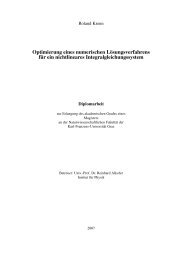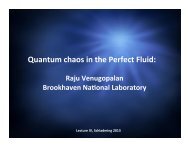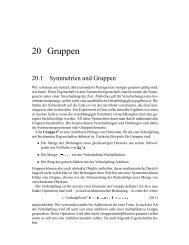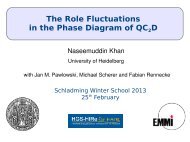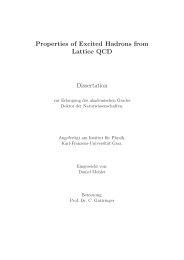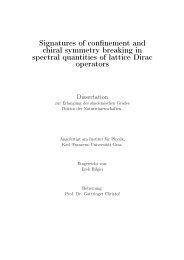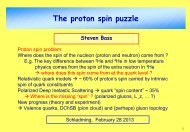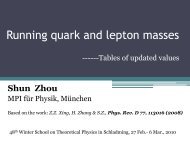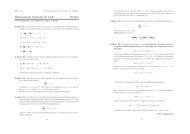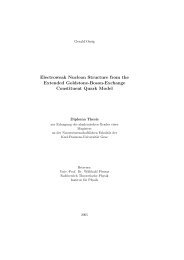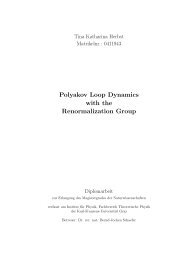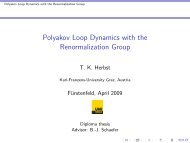The QCD Quark Propagator in Coulomb Gauge and - Institut für Physik
The QCD Quark Propagator in Coulomb Gauge and - Institut für Physik
The QCD Quark Propagator in Coulomb Gauge and - Institut für Physik
Create successful ePaper yourself
Turn your PDF publications into a flip-book with our unique Google optimized e-Paper software.
Chapter 6. Nucleon Form Factors <strong>in</strong> a Covariant Diquark-<strong>Quark</strong> model 65<br />
gauge approach: r (ud)0 + ≈ 1.1 r π. <strong>The</strong> Bethe-Salpeter amplitude is canonically normalised<br />
[IZ] via:<br />
[ ] K ∂<br />
2 =−m 2 J<br />
2 K µ = Π(K, Q)<br />
P<br />
, (6.41)<br />
∂Q µ Q=K<br />
∫ d 4 q<br />
Π(K, Q) = tr<br />
(2π) ¯Γ(q; −K) S(q + Q/2) Γ(q; K) S T (−q + Q/2). (6.42)<br />
4<br />
A solution of the BSE equation requires a simultaneous solution of the quark-DSE<br />
[Mar02]. However, s<strong>in</strong>ce we have already chosen to simplify the calculations by parametris<strong>in</strong>g<br />
S(p), we also employ that expedient with Γ JP , us<strong>in</strong>g the follow<strong>in</strong>g one-parameter forms:<br />
Γ 0+ (k; K) =<br />
1<br />
H a Ciγ 5 iτ 2 F(k 2 /ω 2<br />
N 0+ 0 +) , (6.43)<br />
t i Γ 1+<br />
µ (k; K) = 1<br />
H a iγ µ Ct i F(k 2 /ω 2<br />
N 1+ 1 +) , (6.44)<br />
with the normalisation, N JP , fixed by equation (6.41). <strong>The</strong>se Ansätze reta<strong>in</strong> only that<br />
s<strong>in</strong>gle Dirac-amplitude which would represent a po<strong>in</strong>t particle with the given quantum<br />
numbers <strong>in</strong> a local Lagrangian density: they are usually the dom<strong>in</strong>ant amplitudes <strong>in</strong> a<br />
solution of the ra<strong>in</strong>bow-ladder BSE for the lowest mass J P diquarks [Mar02].<br />
Diquark propagators<br />
Calculations beyond ra<strong>in</strong>bow-ladder truncation elim<strong>in</strong>ate asymptotic diquark states from<br />
the spectrum. It is apparent <strong>in</strong> reference [BHK + 04] that the behaviour of the diquark<br />
propagator ∆ JP can be modelled efficiently by simple functions that are free-particle-like<br />
at spacelike momenta but pole-free on the timelike axis. Hence we employ<br />
∆ 0+ (K) =<br />
∆ 1+<br />
µν(K) =<br />
1<br />
F(K 2 /ω 2<br />
m 2 0 +) , (6.45)<br />
0<br />
(<br />
+ δ µν + K )<br />
µK ν 1<br />
F(K 2 /ω<br />
m 2 1<br />
m 2 1 2 +) , (6.46)<br />
+ 1 +<br />
where the two parameters m J P are diquark pseudoparticle masses <strong>and</strong> ω J P are widths<br />
characteris<strong>in</strong>g Γ JP . Here<strong>in</strong> we require additionally that<br />
( ) ∣<br />
−1<br />
d 1<br />
∣∣∣∣K<br />
F(K 2 /ω 2<br />
dK 2 m 2 J<br />
) = 1 ⇒ ω 2 P J<br />
= 1 P 2 m2 J<br />
, (6.47)<br />
P<br />
J P 2 =0<br />
which is a normalisation that accentuates the free-particle-like propagation characteristics<br />
of the diquarks with<strong>in</strong> the hadron.



